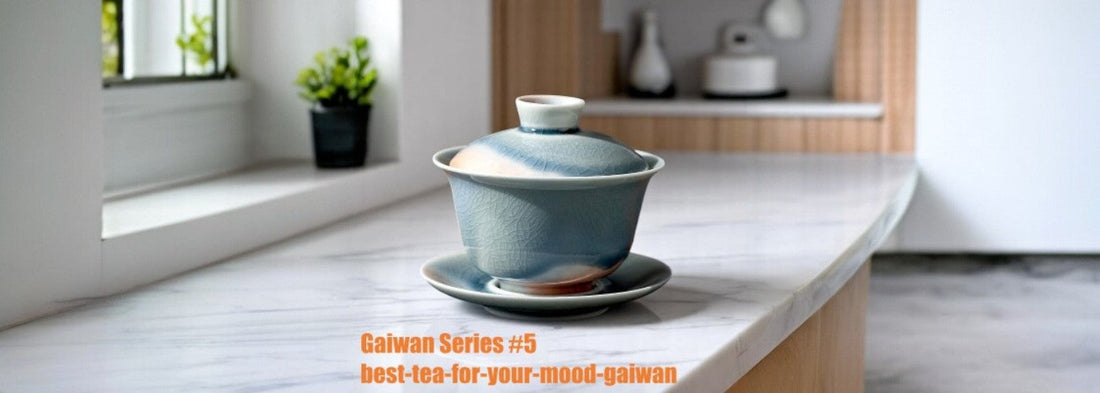
What Tea Is Best for a Gaiwan? A Simple Guide by Type & Mood
Share
When I started brewing tea with a gaiwan, I quickly learned it wasn’t just about technique—it was also about choosing the right tea to match the right moment.
Some teas come alive in a gaiwan. Others feel better suited to a teapot. In this post, I’ll share the teas I personally love brewing in a gaiwan, when I reach for each one, and how I think about gaiwan size the same way some people think about their coffee mugs.
🍵 Gaiwan Sizes, Explained Simply
Most gaiwans fall between 100ml and 180ml, with some even above 200ml. So how do you choose?
Think about it like coffee cups:
- 100–120ml: Like an espresso cup. Great for short, intense steeps or solo tasting.
- 130–160ml: Think flat white or small cappuccino. Flexible enough for daily use, shareable but personal.
- 180–220ml: Like your favorite pour-over mug. More mellow, good for cozy solo sessions or pouring into two cups.
I personally rotate between a 115ml and a 180ml gaiwan depending on the tea and the day.
*This 180ml crackled-glaze gaiwan pairs icy blues with warm amber—a quiet boldness.
🍃 What Teas Work Best in a Gaiwan?
Here are some of my go-to teas for gongfu-style brewing with a gaiwan:
Oolong (the classic choice)
- Rolled oolongs like tie guan yin or high mountain teas open up beautifully in a gaiwan.
- Each steep brings out new layers: floral, sweet, mineral.
- I use water at 90–95°C and steep multiple times in quick infusions.
Puerh (for deep grounding)
- Especially raw puerh, which benefits from tight steeping control.
- A gaiwan helps you notice subtle shifts between each pour.
- Aged shou puerh also works well—smooth, earthy, comforting.
White tea (for quiet moments)
- Fluffy white teas like bai mu dan bloom gently with the open top of a gaiwan.
- Use slightly cooler water (85–90°C).
- Great for rainy days or slow afternoons.
Green tea (trickier, but rewarding)
- More advanced due to temperature sensitivity.
- I use less leaf, shorter steep times, and a lid slightly ajar to prevent overheating.
🌤 Tea by Mood: My Personal Pairings
I often choose tea based on how I feel. Here’s what I reach for in different moments:
- Early morning: lightly roasted oolong for clarity
- Afternoon break: raw puerh or floral Dancong for focus
- Rainy days: white tea or mellow shou puerh
- When I feel restless: green tea to reset
-
When I feel reflective: aged puerh to ground me
🎨 What Gaiwan Should You Brew In?
The tea matters—but so does the gaiwan.
At DeLotus, I handpick pieces that feel good to hold and beautiful to live with. I believe in pieces that elevate the ritual, not just serve a function.
Here’s how I choose what I stock:
- Texture & glaze: I love ice-crackled glazes, aurora colors, and burnt orange or jade tones that reflect nature.
- Size: Most are between 115ml–180ml, great for one or two people.
- Vibe: Whether you're into minimalist wabi-sabi pottery, or cosmic shimmer glazes, I try to offer something that speaks to the mood you want your tea to carry.
🍵 Personal Favorite?
I often reach for my Northern-light glazed gaiwan (150ml) when I want something expressive.
Or my wabi-sabi clay one with carvings, for grounding days when I need texture and stillness.
💬 Final Thoughts
A gaiwan isn’t one-size-fits-all—and neither is tea.
Try different leaves. Notice how they steep, how they feel in the cup, and how they move through you.
If you're curious to try a new tea—or find a new gaiwan for your ritual—take a look around my shop:
👉 www.delotuscrafts.com
I’d love to help you find one that feels just right.
—
Jessie @ DeLotus
Tea drinker, thoughtful packer, and curious wanderer.
